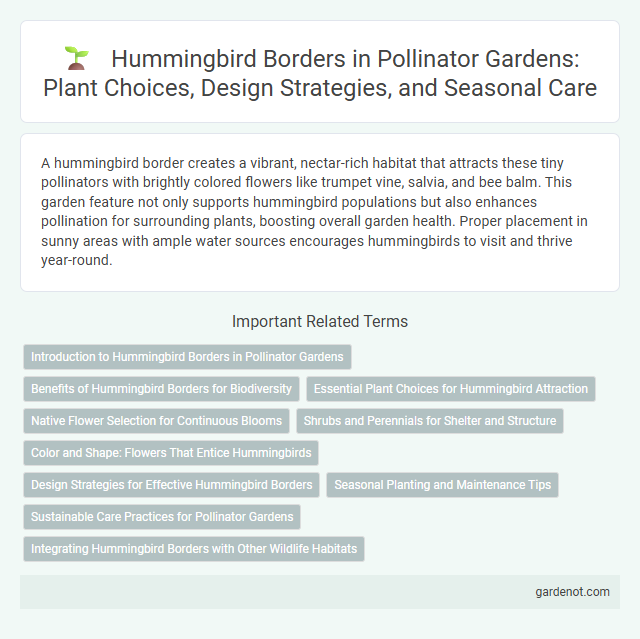A hummingbird border creates a vibrant, nectar-rich habitat that attracts these tiny pollinators with brightly colored flowers like trumpet vine, salvia, and bee balm. This garden feature not only supports hummingbird populations but also enhances pollination for surrounding plants, boosting overall garden health. Proper placement in sunny areas with ample water sources encourages hummingbirds to visit and thrive year-round.
Introduction to Hummingbird Borders in Pollinator Gardens
Hummingbird borders in pollinator gardens are designed with native flowering plants that provide nectar-rich blooms to attract hummingbirds year-round. These borders often include tubular flowers like bee balm, salvia, and columbine, which support the rapid feeding habits of hummingbirds while enhancing biodiversity. Planting a hummingbird border not only aids in pollination but also creates a dynamic habitat for other beneficial insects and wildlife.
Benefits of Hummingbird Borders for Biodiversity
Hummingbird borders significantly enhance biodiversity by attracting diverse hummingbird species, which serve as important pollinators for native flowers and plants. These borders provide essential nectar sources and nesting habitats, supporting local ecosystems and promoting the reproduction of various flora. By fostering a balanced and thriving environment, hummingbird borders contribute to the stability and resilience of pollinator populations and overall garden health.
Essential Plant Choices for Hummingbird Attraction
Selecting tubular, nectar-rich flowers such as trumpet vine, bee balm, and salvia provides an essential food source that attracts hummingbirds to a pollinator garden. Incorporating native plants like columbine and cardinal flower supports local hummingbird populations by offering familiar feeding options and shelter. Including a variety of blooming plants with staggered flowering times ensures a continuous nectar supply, encouraging frequent visits and sustaining hummingbirds throughout the season.
Native Flower Selection for Continuous Blooms
Selecting native flowers such as bee balm, cardinal flower, and trumpet creeper ensures continuous blooms that attract hummingbirds throughout the growing season. These species provide essential nectar sources while adapting well to local soil and climate conditions, promoting a sustainable pollinator garden. Planting a sequence of early, mid, and late bloomers creates an extended floral corridor that supports hummingbird foraging and nesting behaviors.
Shrubs and Perennials for Shelter and Structure
Hummingbird borders thrive with carefully selected shrubs and perennials that provide essential shelter and structural support, including native species like the butterfly bush (Buddleja davidii) and red twig dogwood (Cornus sericea). These plants not only offer refuge from predators and harsh weather but also create vertical layers that attract hummingbirds by enhancing floral visibility and feeding opportunities. Incorporating robust perennials such as bee balm (Monarda didyma) and coral bells (Heuchera spp.) enriches the habitat, ensuring continuous blooms and dense cover throughout the hummingbird active season.
Color and Shape: Flowers That Entice Hummingbirds
Vibrant red tubular flowers in the hummingbird border attract these agile pollinators by mimicking the shape of their favorite nectar sources. Bright blooms such as trumpet vine, bee balm, and fuchsia offer accessible nectar with shapes perfectly suited to hummingbirds' long beaks and hovering flight. Selecting flowers with rich, warm colors and elongated petals enhances pollination by ensuring hummingbirds' preference for vivid hues and shapes is met.
Design Strategies for Effective Hummingbird Borders
Incorporate native flowering plants with tubular shapes and vibrant colors like red, orange, and pink to attract hummingbirds effectively. Layering plant heights and ensuring continuous bloom cycles from spring to fall supports sustained nectar availability and shelter. Position the border near water sources and open perches to enhance hummingbird feeding and resting opportunities.
Seasonal Planting and Maintenance Tips
Select a variety of nectar-rich plants such as trumpet vine, bee balm, and salvia, ensuring continuous blooms from spring through fall to support hummingbirds throughout the seasons. Regularly deadhead spent flowers and prune dense foliage to promote healthy growth and maintain garden accessibility for pollinators. Monitor for pests organically and provide fresh water sources to optimize the garden's attractiveness and sustainability for hummingbirds year-round.
Sustainable Care Practices for Pollinator Gardens
Integrating native flowering plants such as bee balm, salvia, and trumpet vine into your hummingbird border supports sustainable care by promoting natural pollinator activity and reducing water usage. Employing organic mulches and drip irrigation conserves soil moisture and minimizes weed growth, fostering a healthy ecosystem without chemical inputs. Regularly monitoring plant health and using companion planting strategies enhances biodiversity and resilience in pollinator gardens, ensuring long-term sustainability.
Integrating Hummingbird Borders with Other Wildlife Habitats
Hummingbird borders enhance pollinator gardens by providing nectar-rich flowers that attract hummingbirds, supporting their feeding and breeding activities. Integrating these borders with butterfly gardens and native shrubbery creates a diverse habitat, promoting a balanced ecosystem and increased biodiversity. Strategic plant selection ensures continuous bloom cycles, facilitating year-round nourishment for multiple wildlife species.
Hummingbird border Infographic

 gardenot.com
gardenot.com